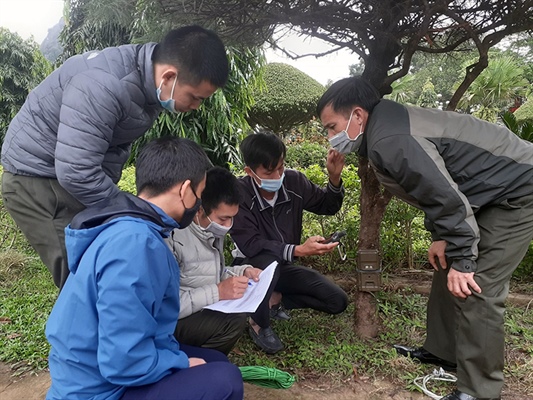May 27, 2025 | 07:03 GMT +7
May 27, 2025 | 07:03 GMT +7
Hotline: 0913.378.918
May 27, 2025 | 07:03 GMT +7
Hotline: 0913.378.918

The trainees were introduced by experts to the techniques of installing camera traps. Photo: TH.
Upon implementing the 2021 plan of the Constituent of Biodiversity Conservation under the USAID Sustainable Forest Management and Biodiversity Conservation Project (VFBC for short), Phong Nha - Ke Bang National Park (PNKBNP) Management Board, in collaboration with Quang Binh VFBC Project Management Board and Fauna & Flora International (FFI), organized a training course on biodiversity surveying for twenty-one PNKBNP technical staff and twenty-six members of PNKBNP Forest Protection Unit (FPU) along with FFI experts and technical staff.
The training course focuses on camera traps and threats investigation in Phong Nha - Ke Bang National Park. At the training course, the trainees were introduced by experts from FFI and Leibniz Institute for Zoo and Wildlife Research (IZW) to camera trap and the Spatial Monitoring and Reporting Tool (SMART).
The contents include: techniques for installing camera traps and collecting data on survey routes for main members of the survey group; guidance for trainees on the steps to collect data on survey routes for the community groups near PNKBNP that support the survey groups; brief introduction on the Standard Operating Procedure (SOP) for camera trap installation and camera trap data collection; data update from survey teams onto the SMART Desktop database; and installation of SMART mobile app on smartphones. The survey teams also opened discussions to assign specific responsibilities to each member.
Through the training course, the participants proficiently used smartphone applications to collect camera trap data, contributing to the survey of biodiversity and threats in Phong Nha - Ke Bang National Park.
According to Mr. Pham Hong Thai, Director of Phong Nha - Ke Bang National Park, the training course will help participants when participating in the field survey to firmly grasp the technical requirements and fully practice the steps of installing photo traps in accordance with the SOP. They will also learn to use the SMART mobile app to collect camera trap data on survey routes. By the end of the training the trainees should be able to clearly understand the field plan of the group and clearly assign responsibilities to each member of the survey team. They will also plan to coordinate the organization of logistics and daily logistics for the survey team.
All the techniques given in the training course will help participants effectively perform the functions and tasks assigned to the survey of biodiversity and threats in Phong Nha - Ke Bang National Park.
According to Quang Binh Department of Agriculture and Rural Development (DARD), Quang Binh VFBC Project utilizes capital from non-refundable aid from the USD 2 million fund from the United States Agency for International Development (USAID). The provincial budget's reciprocal capital is VND 5,141 million VND. The project implementation period is 6 years (2021 - 2026).
Quang Binh VFBC Project Management Board is responsible for helping the povincial People's Committee and the DARD by acting as the focal point for general coordination, management and implementation of the project in accordance with the objectives, progress, quality and human resources stated in the approved project documents.
The Management Board must comply with the provisions of the Sponsor (USAID) and the laws of Vietnam, and may use the seal of the Department of Forest Protection and open an account to initiate operation.
The main office is at the headquarters of Quang Binh Department of Forest Protection.
Translated by Khanh Linh
/2025/05/25/4127-3-073637_820.jpg)
(VAN) Thanks to the promotion from an FAO-implemented project, vegetable production in greenhouses in Moc Chau has seen strong development, from 1.5 hectares in 2021 to nearly 50 hectares in 2024.

(VAN) FAO has recently supported USD 140,000 to implement the project 'Risk mitigation human-animal interface risks through disease control initiatives in pig farming.'

(VAN) The People's Committee of Tra Vinh province has approved an adjustment to the investment policy for the Green Hydrogen Plant project, increasing its area to approximately 52.76 hectares.
![Reducing emissions from rice fields: [2] Farmers’ commitment to the soil](https://t.ex-cdn.com/nongnghiepmoitruong.vn/608w/files/news/2025/05/05/dsc08881jpg-nongnghiep-140632.jpg)
(VAN) Clean rice cultivation model in Thuong Tan commune, Bac Tan Uyen district, is assisting local residents in achieving sustainable agriculture by substantially reducing costs, increasing productivity, and protecting the environment.

(VAN) At the conference to disseminate Resolution No. 68, AgriS introduced its digital agricultural ecosystem and reaffirmed its commitment to accompanying the Government in promoting private sector development and sustainable agriculture.

(VAN) 'Blue Ocean - Blue Foods' initiative is designed to restore marine ecosystems and establish sustainable livelihoods for local communities by cultivating a minimum of 1,000 hectares of cottonii seaweed in the first three years.
/2025/05/21/4642-3-112707_603.jpg)
(VAN) The V-SCOPE project has made direct contributions to three out of six pillars of the Comprehensive Strategic Partnership between Vietnam and Australia.